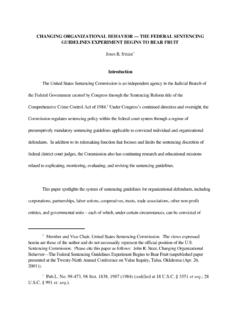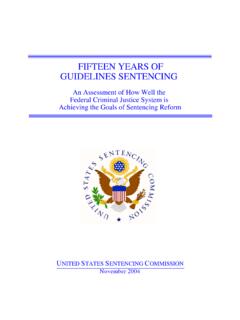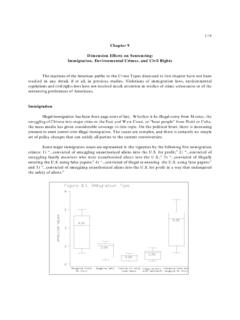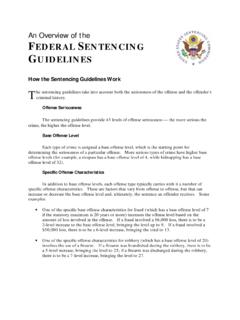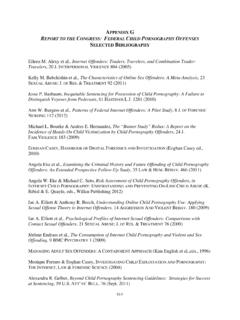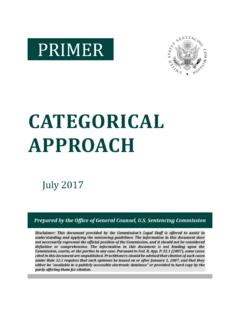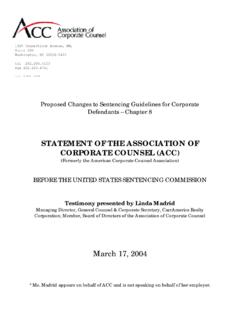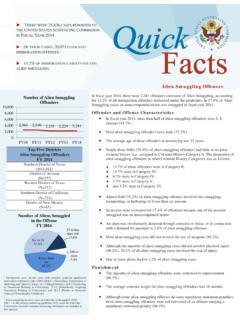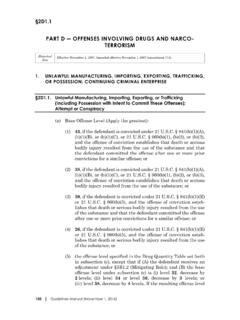Transcription of Demographic Differences in Sentencing: An Update to the ...
1 Demographic Differences in Sentencing: An Update to the 2012 Booker ReportUNITED STATES SENTENCING COMMISSIONW illiam H. Pryor, Jr. Acting ChairRachel E. BarkowCommissionerCharles R. BreyerCommissionerDanny C. ReevesCommissionerZachary C. BolithoEx Officio J. Patricia Wilson SmootEx OfficioKenneth P. Cohen Staff DirectorGlenn R. SchmittDirectorOffice of Research and DataNovember 2017 United States Sentencing CommissionOne Columbus Circle, Washington, DC R. Schmitt, , , Director, Office of Research and Data Louis Reedt, , Deputy Director, Office of Research and Data Kevin Blackwell, Senior Research Associate, Office of Research and Data Section I: Analysis of Demographic Differences in Multivariate Regression Analysis is II: The Commission s Updated of Findings from the Commission s Updated Multivariate of Demographic Multivariate Regression Analysis for All of Differences in Sentencing by Guideline of Likelihood of Obtaining a Below Range Effect of Adding Data on Prior Violence as a Factor in the Limitations of Regression III: Appendix A: Analysis of Other Demographic Appendix B: Offense Specific Appendix C: Appendix D.
2 Regression Model OF CONTENTSD emographic Differences in SentencingitSection IIntroductionDemographic Differences in Sentencing2 Introduction In 2010, the Commission published an analysis of federal sentencing data which examined whether the length of sentences imposed on federal offenders was correlated with Demographic characteristics of those That analysis found that some Demographic factors were associated with sentence length to a statistically significant extent during some of the time periods Among other findings, the analysis showed that Black male offenders received longer sentences than White male offenders, and that the gap between the sentence lengths for Black and White male offenders was increasing. In 2012, the Commission updated this analysis by examining cases in which the offender was sentenced after the release of the 2010 The Commission also expanded its analyses to examine Demographic Differences in sentences based on a comparison of the position of the sentence imposed relative to the sentencing guideline range that applied in the case; based on the type of offense committed by the offender, including drug trafficking, fraud, and firearms; and based on changes in sentence length for offenders of particular race and gender pairings.
3 These findings were released as part of the Commission s comprehensive report4 on sentencing practices after the Supreme Court s decision in United States v. In its 2012 report, the Commission found that the type of Demographic Differences in sentencing reported in 2010 continued to be observed in sentencings that occurred after that report. The Commission has once again updated its analysis by examining cases in which the offender was sentenced during the period following the 2012 report. This new time period, from October 1, 2011, to September 30, 2016, is referred to as the Post-Report period in this publication. Also, the Commission has collected data about an additional variable violence in an offender s criminal history that the Commission had previously noted was missing from its analysis but that might help explain some of the Differences in sentencing noted in its work. This report presents the results observed from adding that new data to the Commission s FindingsConsistent with its previous reports, the Commission found that sentence length continues to be associated with some Demographic factors.
4 In particular, after controlling for a wide variety of sentencing factors, the Commission found: Black male offenders continued to receive longer sentences than similarly situated White male offenders. Black male offenders received sentences on average percent longer than similarly situated White male offenders during the Post-Report period (fiscal years 2012-2016), as they had for the prior four periods studied. The Differences in sentence length remained relatively unchanged compared to the Post-Gall period. Non-government sponsored departures and variances appear to contribute significantly to the difference in sentence length between Black male and White male offenders. Black male offenders were percent less likely than White male offenders to receive a non-government sponsored downward departure or variance during the Post-Report period. Furthermore, when Black male offenders did receive a non-government sponsored departure or variance, they received sentences percent longer than White male offenders who received a non-government sponsored departure or variance.
5 In contrast, there was a percent difference in sentence length between Black male and White male offenders who received sentences within the applicable sentencing guidelines range, and there was no statistically significant difference in sentence length between Black male and White male offenders who received a substantial assistance departure. Violence in an offender s criminal history does not appear to account for any of the Demographic Differences in sentencing. Black male offenders received sentences on average percent longer than similarly situated White male offenders, accounting for violence in an offender s past in fiscal year 2016, the only year for which such data is available. This figure is almost the same as the percent difference without accounting for past violence. Thus, violence in an offender s criminal history does not appear to contribute to the sentence imposed to any extent beyond its contribution to the offender s criminal history score determined under the sentencing guidelines.
6 Female offenders of all races received shorter sentences than White male offenders during the Post-Report period, as they had for the prior four periods. The Differences in sentence length decreased slightly during the five-year period after the 2012 Booker Report for most offenders. The Differences in sentence length fluctuated across all time periods studied for White females, Black females, Hispanic females, and Other Race female offenders. Demographic Differences in Sentencing3 Multivariate Analysis of Demographic Differences in Sentencing For this report and in its prior two reports, the Commission has used multivariate regression analyses to explore the relationships between Demographic factors, such as race and gender, and sentencing outcomes. These analyses were aimed at determining whether there were Demographic Differences in sentencing outcomes that were statistically significant, and whether those findings changed during the periods studied.
7 Multivariate regression analysis usually begins with a decision to examine an observed phenomenon or outcome. In the Commission s work, the outcome observed are the sentences imposed in federal cases. The researcher will then develop a hypothesis as to the many possible factors that might produce that outcome. Among the factors considered by the Commission were the type of offense, the sentencing range determined by the court in each case using the Commission s Guidelines Manual,6 and whether the offender was subject to a mandatory minimum penalty. The hypothesis is then tested using multivariate regression analysis to bring together data about the outcome and many possible factors that might affect that outcome. The goal of multivariate regression analysis is to determine whether there is an association between the factors being studied and, if so, to measure the extent to which each factor contributes to the observed outcome.
8 Researchers refer to the outcome (in this report the length of the sentence imposed) as the dependent variable. The factors that might affect (and therefore might explain) that outcome are referred to as the independent variables or the explanatory variables. 7 The principal benefit of multivariate regression analysis is that it controls for the effect of each factor in the analysis by comparing offenders who are similar to one another in relevant ways. By controlling for such factors and comparing similarly situated offenders, this multivariate regression analysis seeks to answer the question: if two offenders are similar in certain ways, what other factors might be associated with those two offenders receiving different sentences? In addition, multivariate regression analysis measures the extent of the difference in outcomes. Multivariate regression analysis often cannot control for all possible factors that might affect the outcome being studied, typically because sufficient data about some factors is not readily available.
9 For example, in its past reports, the Commission noted some potentially relevant factors were not included in its analyses, such as whether the offender s criminal history included violent criminal conduct, the offender s family ties, and the offender s employment Data was not readily available for those factors because the Commission did not routinely extract that information from the court documents it Therefore, for those prior analyses, the Commission could not control for For this reason, caution should always be used when drawing conclusions based on multivariate regression analysis. Why Multivariate Regression Analysis is Helpful Multivariate regression analysis can be helpful when considering Demographic Differences in sentencing outcomes because results from more simplistic data analyses that examine only selected Demographic factors and sentencing outcomes can be misleading. Such simplistic analyses may yield results that might appear to indicate that Demographic factors correlate with sentence length, when the actual correlation may be attributable to other, non- Demographic factors, such as the type of offense committed or whether the offense was one for which a statutory mandatory minimum penalty applied.
10 Most importantly, simplistic analyses do not consider the effect of the guideline range provided for under the sentencing guidelines, which takes into account, among other things, the type of offense, the presence of aggravating or mitigating factors, and the criminal history of the offender. For example, a simplistic pairing of recent data regarding race and gender with sentence length shows that sentences of Black male offenders have always been longer than those of White male offenders. As shown on figure 1, however, the average sentences for Black male offenders were shorter during the Post-Report period (fiscal years 2012 to 2016) than during the Booker period (January 2005 to December 2007), and the Gall period (December 2007 to the end of fiscal year 2011). At the same time, the average sentence for White male offenders increased during the Post-Report period after a slight decrease in the Gall period.
